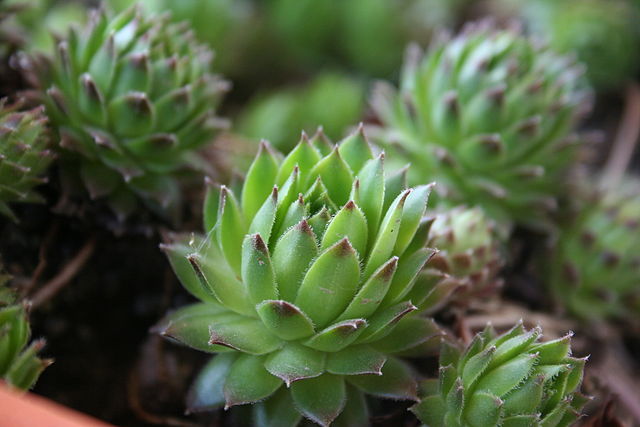6 plants that can survive a winter in a college student’s room
Image via Aaron Hyatali, Wikimedia Commons
A potted succulent plant.
January 12, 2023
Plants are a great way to create a cozy and bright living space even with the constant gray skies of a Pittsburgh winter, but few college students have the resources to let their inner green thumb shine through.
Here are six plants that can survive the winter in a dorm room, along with some plant care tips to keep them alive.
You can often find these plants at local plant shops like Ruby Flora in Bethel Park, Synthesis in Shadyside, or a plant vendor from pop-ups like The Neighborhood Flea. Home improvement stores such as Home Depot or Costco also occasionally sell succulents, cacti and bamboo.
Lucky bamboo is a popular house plant that is notoriously indestructible. It is not bamboo at all, but rather a type of Dracaena. It’s a hardy, fast-growing, low-maintenance plant that prefers low-light and infrequent watering. Lucky bamboo can grow in twisted and sculpted stalks that add vivid decoration to a dorm or apartment.
The plant has Chinese roots 一 and Chinese people often give it as a gift because it contains meanings that coincide with the number of stalks. For example, two stalks represent the Chinese belief that all good things come in pairs, so couples often receive a two-stalk bamboo as a gift. Two stalks broadly represent love.
Four stalks are bad luck 一 the Chinese word for four is close to the word for death, so they are considered a death wish. Five stalks represent the balance of the five areas of health 一 emotional, spiritual, mental, intuitive and physical. The culture considers seven stalks as lucky and believe them to bring good health.
Lucky bamboo grows best in well-drained, moist 一 but not soaked 一 soil. It can also thrive in water as long as you change it weekly and completely cover the roots. The plant is sensitive to chemicals, so it is best to water it with bottled or distilled water.
Succulents come in many varieties and are a cheap, small option for students. Any plant with thick, fleshy leaves that store water is technically a succulent. They grow in a variety of shapes, including paddle leaves, rosettes and trailing teardrop leaves. These robust plants enjoy direct sunlight but are perfect for people who forget to water their plants. You can water succulents once a month in the winter. Succulents are extremely common and are often found in any store that sells plants.
When buying any plant, it’s better to purchase a smaller plant rather than a large one. A tiny plant can establish itself better in its new home and have a larger ratio of roots to top growth.
This plant is a branch of succulent that produces a soothing gel that people use to treat sunburns. If you have pets, avoid this plant 一 its leaves are toxic for animals. During spring and summer, aloe vera requires regular watering whenever the soil goes completely dry. During the winter, the plant goes dormant and requires watering only about once a month.
Less is more when watering any plant. A common misconception that new plant owners have is that they’re not watering their plants enough. Many of these plants come from dryer climates and are susceptible to root rot, a fatal disease where the plant’s root system deteriorates. Watering too much will kill a plant faster than forgetting to water it.
Use pots with drainage holes. These are little holes in the bottom of the pot that let excess water drain, which allows the roots to breathe and helps prevent roots from getting waterlogged.
These prickly plants are very popular house plants. They come in many fun shapes and sizes, some even grow flower blooms. Cacti need well-draining soil and a pot with drainage holes to avoid waterlogged roots. They benefit from watering every week during the summer as long as the soil completely dries in between sessions. During the winter, they become dormant and require less frequent watering.
Avoid putting your plants in drafty rooms. Most plants enjoy humidity and will experience stress if placed by the air conditioner or windows.
Air plants don’t require soil, so they’re often sold in glass terrariums, geometric cases or decorative driftwood that make for an interesting house decoration. Rather than taking nutrients from the soil, they absorb them from the air. They are usually small, fitting in the palm of a hand and thrive best in bright, indirect light. Water air plants about once a week, either by soaking them in a glass of water for an hour or misting them regularly.
Be sure to consider light exposure when picking a spot for a plant. Many houseplants will burn if kept in direct light, but providing adequate indirect light is crucial, especially during the winter. Rotating your plant is also beneficial to evenly distribute light.
It’s also always useful to give your plant a haircut. Snipping off dead growth will help the plant grow healthy stems.
This plant features stiff, sword-like leaves and can range anywhere from six inches to eight feet tall. It is slow-growing but extremely hard to kill. Snake plants don’t require much water, going two months between waterings in the winter, but are susceptible to overwatering and root rot. They prefer steady, indirect light but are adaptable to all light conditions.








